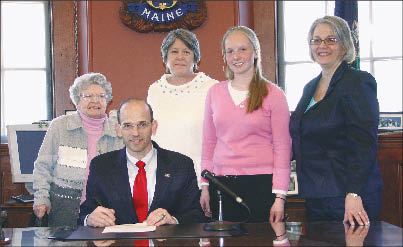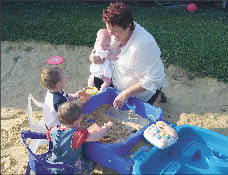Best practice theories hold that foster children should maintain contact with their biological parents unless there’s strong reason not to. Until recently, however, little thought was given to maintaining what is often the longest-lasting relationship of a person’s lifetime: the one with siblings.
"The system’s just not set up" for siblings to stay connected in foster care, says Gail Biro, vice president of the Neighbor to Family child welfare agency in Daytona Beach, Fla. "It’s s like you’re on a farm, and you have a litter of kittens, and it’s a ‘whoever-will-take-one’ kind of thing."
But "the whole issue of siblings has been coming to the forefront since about ’02," says Millicent Williams, director of foster care for the Child Welfare League of America (CWLA). "The issue of sibling placements and the strong bonds and connections probably started in the adoption field. Then it moved into looking at the initial placement of kids in foster care."
Last October, Casey Family Programs convened the Foster Youth and Alumni Leadership Summit, bringing together foster youths who have siblings and leaders in the child welfare field. The youths noted "that they were not placed together" with their brothers or sisters, said the summit report, "and many did not know where their siblings were and had not seen them for years."
 |
| Rewarding moment: Former foster youth Kala Clark (second from right) stands next to Maine Gov. John Baldacci as he signs a sibling visitation law that she helped to create. Standing with them are (left to right) Clark’s grandmother, Kay Smith; her mother, Catherine Hodgkins; and Maine Department of Health and Human Services Commissioner Brenda Harvey. |
The report recommends that siblings be placed together or, when they cannot be, that courts order visits between them. In cases of separation, the report also suggests giving the youths phone cards so they can call each other, and updates when the contact information changes.
Siblings aren’t placed together for several reasons, including the simple fact that child welfare managers haven’t focused on trying. There’s also the issue of whether foster care facilities have enough room to take groups of youths and keep them together. Agencies have to follow regulations “about what you’re allowed and not allowed to do in terms of room size, number of people to a home, all those kinds of things,” says Bob Friend, assistant director of the California Permanency for Youth Project.
Several programmatic and legislative efforts are helping to keep foster siblings connected.
Among the first organizations to make sibling connections was Camp To Belong, which began in Colorado in 1995 and has expanded to six locations in the United States and Canada.
“It’s one thing to be separated from your parents,” says founder Lynn Price. “But we usually are closer, even, with our siblings. You have to look to each other to survive.”
Other privately run programs – like Neighbor to Neighbor, based in Chicago, and Neighbor to Family, based in Daytona Beach, Fla. – look to fill that void year-round. The programs pay foster parents extra, through salaries and benefits, to take in sibling groups. “We’re hoping this catches on,” says Gordon Johnson, CEO of Neighbor to Family, who founded the Chicago-based program when he worked at the Jane Addams Hull House Association in 1994. “It doesn’t have to be our program.”
Founded in the wake of a lawsuit filed by the American Civil Liberties Union, Neighbor to Neighbor differs from its larger cousin in Daytona Beach in that it strives to accept sibling groups only of four or more – an especially pressing need in an urban area like Chicago, says Vanessa Lankford, director of Neighbor to Neighbor.
Program founder Johnson led the Illinois Department of Children and Family Services for seven years, ending in 1990, after working in the New York and Pennsylvania child welfare departments. “Through all those collective experiences, we tried through the bureaucracy in many ways to address foster care concerns,” he says. “I found the bureaucracy itself could not do it. We needed some new, innovative ways from the outside.”
“It’s absolutely insane that we don’t have the common sense to keep families together,” says Kathleen Bushong, a foster parent with Neighbor to Family. “Keeping sibling groups together helps heal the family faster.”
Government Action
Twenty-eight states have passed legislation focused in some fashion on maintaining sibling connections, according to Williams at CWLA. Among the examples:
• Maine passed legislation last year that gives judges the authority to order sibling visitation during semiannual case reviews. The law was inspired by Kala Clark, a foster youth in high school who wrote to Gov. Tom Baldacci as part of a class assignment.
“She had experienced being apart from her brothers, having different guardians – and if one guardian said they weren’t going to visit, they wouldn’t visit,” says Penthea Burns, who coordinates the youth leadership advisory team at the University of Southern Maine’s Muskie School of Public Service, where Clark, now 19, works as a researcher. “She wanted siblings to have legal rights to visit each other and [a law to] give judges the authority to order it.”
The legislation relies on court-appointed special advocates or guardians ad litem to raise such issues at the judicial reviews, Burns says.
Clark, who lives 15 miles from her two younger brothers, says the law has not helped her, because she turned 18 a week before it passed, and her siblings live with their biological mother. Nonetheless, “it was a pretty good birthday gift,” she says. “If one of them were in foster care, they would be able to petition the court to see me.”
• California passed legislation in 2000 that requires social workers to include in their court reports a section on sibling visitation plans. Members of policy advocacy organization California Youth Connection see the state law as a first step, says Associate Director Tiffany Johnson.
While she believes the law needs more “meat,” Johnson calls it “a value statement about people recognizing the importance of sibling connections. It is really hard to get that value embedded into a system.”
• Iowa has legislation in the works that would require the state Department of Human Services to make “reasonable efforts to always place kids together” or “reasonable efforts to ensure visitation,” says Jerry Foxhoven, director of the Middleton Center for Children’s Rights at Drake University.
“It isn’t that [decision-makers] are necessarily opposed to visitation right now,” he says. “The issue is, they’re not focused on that. This forces them to focus on that, and it forces them to implement it or explain why they aren’t.”
The Middleton Center worked with a youth group called Elevate 2 Inspire in crafting the legislation, Foxhoven says. “What a novel idea,” he says with a laugh. “Let the youth in the system decide what needs to be changed about the system.”
Following are examples of efforts to keep siblings together or to reconnect them after they’ve been separated by foster care.
Ed Finkel can be reached at edfinkel@earthlink.net
One of the Originals
Camp To Belong
Colorado-based
 |
|
Getting closer at Camp to Belong.
Photo: Photo by Ed Andrieski |
(303) 791-0915
The Approach: The volunteer-run Camp To Belong forms partnerships with residential camp sites to hold five-night, six-day gatherings during which siblings swim, ride horses, do art projects and engage in other typical summer camp activities. Those ages 14 and older attend life seminars and visit colleges. The camps feature a mass birthday party, when siblings blow out candles together and create some of the shared memories that they have missed by being apart.
“Rather than reminisce about when the police showed up at your door, or the heartaches and troubles, you’re talking about this summer camp,” says founder Lynn Price. “They’re having a good time at camp, but they’re also seeing why their relationship is important.”
Price grew up in foster care in Chicago. “I had been separated from my sister, and back then there was not an incentive for us to get to know each other,” she says. “We realized that, for all the things that were different about us, and the distance and time between us spending time together, we had a lot in common.”
The camps attempt to provide the “unconditional loving environment” that siblings may lack the rest of the year, Price says.
History: Price says she was inspired to launch the camps after doing research that showed three-quarters of the 600,000 kids in foster care were separated from at least one sibling. Founded in 1995, Camp To Belong has locations in Colorado, Maine, Massachusetts, Nevada and Idaho. It is in negotiations to open programs in Arizona, Georgia, California, Hawaii, the Washington, D.C., area, the United Kingdom and Australia. A camp for Canadian foster children, located in Louisville, Ky., will move to Canada next summer.
Youth Served: Each camp serves between 65 and 100 kids, ages 8 and up.
Staff: Each site has one paid independent contractor to coordinate the effort. Price fills that role in Colorado, while simultaneously working to spur the organization’s overall growth. Most of the work is done by about 250 volunteers – “social workers, foster parents, students, parents, construction workers, software engineers, people who truly bring the best of their passion,” Price says. “If you bring only people from the [child welfare] system, they’ve already got a mindset, and we’ve got to step out of that mindset.”
Funding: The camps all have different budgets – $16,000 in one case, $50,000 in another – to pay the contractor and, in some cases, to pay for the host facilities. Most monetary contributions come from individuals, families and “mom-and-pop” foundations, Price says. Some camps receive business or government funding.
Indicators of Success: Camp To Belong has conducted pre- and post-camp surveys of campers and counselors but has not tallied results in any meaningful way, Price says. “We haven’t moved that into a really effective reporting situation yet,” she says.
She believes the camps are a factor behind the growing numbers of state laws governing sibling visitation and in families willing to take in foster siblings.
There’s one thing she can quantify: “One hundred percent of our kids now have memories with their siblings because they have come to camp.”
A State Effort
Department of Children and Families
State of Connecticut
(860) 550-6300
The Approach: Connecticut is just getting started on a federally funded effort to unify siblings, but even at this early stage, it appears far ahead of most states. The state Bureau of Child Welfare Services has asked its 14 regional offices to develop plans, using a $200,000 grant.
“Part of that may be providing stipends to foster parents to go to movies, to go to dinner, to do various functions and help support them financially,” says Kim Nilson, who administers the grant for the bureau. A Request for Proposals will be issued this summer to the regional offices.
“They’re coming up with whatever they think is best to facilitate that connection and communication,” Nilson says. The offices, each of which covers several counties, are receiving pro-rated amounts, based on their respective caseloads.
The grant funds could go toward contracts with local agencies to help provide activities and supervision, Nilson says. “It could be lunches, dinners, tickets to museums,” she says. “One office purchased plane tickets so that another sibling could visit, who was out of state. They contracted with a private agency to help facilitate that.”
The state continues to research methods for maintaining such connections, says Sarah Wilhelm, independent living program coordinator in the Bureau of Adolescent and Transitional Services. It is hoped that surveys of staff and foster youth will bring in some “outside the box” ideas, she says.
One idea under discussion for statewide use is a “sibling survival kit” for those placed separately that might include a digital camera, pharmacy gift cards for photo processing, and a 4- by 6-inch picture frame; stationery, pens and envelopes for writing letters; age-appropriate books and magazines; and a pillowcase on which siblings could write notes to one another, Wilhelm says. “I’m still with you, Johnny. See you in your dreams,” she says.
The department also has discussed providing siblings with long-distance calling cards and gift cards to buy birthday cards for one another. “Do we want to get pre-stamped envelopes so the kids can write letters back and forth?” she says. “A lot of it is going to depend on the most appropriate type of connection for each sibling group.”
The state is also looking into securing slots at camps that focus on sibling connections, and “evaluating the reality of bringing a weeklong camp to Connecticut,” Wilhelm says.
History and Organization: The grant was received in 2006.
Youth Served: In November 2006, the state had 2,505 siblings placed in foster care, 1,420 of whom were not placed together with all of their siblings, and 490 of whom were not placed with any siblings. The latter group is receiving the most focus under the new effort, Nilson says.
Staff: Nilson does not foresee any new staff for the sibling effort under the grant. “It’s more about the staff in the area offices managing their own caseload and developing individual plans for their own kids,” she says. “Part of social workers’ responsibility is to ensure that happens.”
Funding: The sibling visitation program receives $200,000 in funding through a Promoting Safe and Stable Families grant, under the U.S. Department of Health and Human Services.
Indicators of Success: When it starts to calculate results, Wilhelm believes the department will set a goal of placing a certain percentage of siblings together and providing regular visits among siblings who are not together.
Professional Foster Parents
Neighbor to Family
Daytona Beach, Fla.
(386) 523-1440
 |
|
Johnson: “My God, this could raise the standards.”
|
The Approach: Neighbor to Family (NTF) hires foster care providers at salaries of $11,000 to $17,000 per year and provides benefits and training so they can care for groups of two or more siblings – and can be held accountable. The organization accepts sibling groups of any size and gives no foster family more than one sibling group at a time.
Keeping siblings together, the agency says, not only minimizes feelings of loss in the youth, but is more cost-effective, because grouping the youths reduces the number of placement homes needed. NTF says the training, pay and grouping raise staff and caregiver morale and longevity.
“You don’t have to pay a lot of money to make the foster parent feel professional,” says CEO Gordon Johnson. By offering payments, “we were able to be more selective. I thought, ‘My God, this could raise the standards.’ ”
“They put their foster parents first. They always say that foster parents are key to the organization,” says Kathleen Bushong, who has worked for Neighbor to Family for about six years. She says she has cared for about 24 foster children, including a group of three – ages 5 months, 18 months and 2½ years – who have been with her since Thanksgiving.
“They customize case plans for the family,” she says of NTF.
The foster parents not only care for the children, but mentor and coach birth parents until the youth are returned to them, says Gail Biro, vice president. “We’re able to keep the kids together and get them to permanency much quicker,” she says.
 |
|
Child’s play: Bushong in her yard with three of her foster children – all siblings.
|
The agency takes the same approach in cases where children are adopted, working with families before and after the adoption for “as long as necessary. No time limit,” Johnson says.
In addition to Daytona Beach, the program’s service area includes Miami and Orlando, Fla.; Norfolk, Va.; Baltimore; and five counties in the Atlanta region. Each state child welfare system works somewhat differently, but Johnson says, “We will not go into any state or locality that is not willing to make certain changes,” including keeping siblings together.
History and Organization: After establishing Neighbor to Neighbor at Jane Addams Hull House Association in Chicago in 1994, Johnson took the program to Daytona Beach in 1998, and in 2000 it officially incorporated as Neighbor to Family, selected as the implementation model for a sibling-group foster-care pilot program mandated by state legislation.
Youth Served: About 525 children, Biro says.
Staff: Approximately 500 staff in six locations, Johnson says, including about 280 foster caregivers.
Funding: The agency’s budget is $25 million to $30 million per year. Most of the funding comes from federal Title IV-E and IV-B dollars that flow through state children and family agencies, Biro says. In Georgia, she says, counties provide some matching dollars.
Indicators of Success: A study by the Ounce of Prevention Fund and the University of Florida School of Social Work found that all 68 sibling groups remained together in their initial placements, for as long as they were in the care of Neighbor to Family. All the youths increased their self-esteem, as measured by pre- and post-testing in the study; 91 percent made progress toward developmental milestones; 79 percent increased their academic performance; and 67 percent improved their social skills.
Johnson says the program has shown considerably shorter lengths of stay in foster care than the state average. For example, he says that in Maryland the average stay is 46 months, but the stay for youths in Neighbor to Family is eight months.
Relying on Volunteers
Project Visitation
 |
|
A day at the beach gives siblings new memories …
Photo: Photos courtesy of Volunteer Legal Services |
Volunteer Legal Services Hawaii
Honolulu, Hawaii
(808) 528-7050
The Approach: Volunteers facilitate monthly visits among separated siblings. The organization holds camps in July and August, a Christmas party, and other types of get-togethers at water parks, movie theaters and kid-friendly hangouts like Chuck E. Cheese’s. Project Visitation secures gift certificates for some of those venues.
“We get community volunteers who are willing to spend their time arranging the visits, facilitating with the parents and their kids,” says case manager Nancy Lefler-Panela. Activities include “whatever the kids want to do, and the foster parents are OK with. It’s pretty open-ended.”
Referrals come through social workers at the state Department of Human Services (DHS), says Vince Abramo, the project’s communications coordinator.
“Part of our mission is to bring awareness to the community as well – not just provide the service,” says Dung Vo, operations manager for Project Visitation. “We want the community involvement.”
Adds Lefler-Panela, “We’re working on growing, getting more volunteers, getting the community more involved.”
 |
|
… that won’t be shaken out by a moon bounce.
Photo: Photos courtesy of Volunteer Legal Services |
History and Organization: Abramo says Family Court Judge R. Mark Browning launched the organization in April 2001 after promising a girl in juvenile detention that he would arrange for her to see her brothers and sisters.
“She was on the run, jailed for robbery,” Abramo says. “The next year, he saw her again in juvenile detention. She said she waited for three or four months, [and] the visit never happened. She ran again, and then she got in trouble with the law again. He decided to change the whole system and make [sibling visits] a priority.”
In an interview with the Honolulu Star-Bulletin in 2002, the judge said that foster siblings “routinely are not seeing each other for months or years. In my way of thinking, it’s systemic abuse. The only love and care left, in many instances, is from siblings.”
Housed at Volunteer Legal Services Hawaii, Project Visitation is a public-private partnership that includes DHS, the Na Keiki Law Center, Family Court of the First Circuit, Foster Family Programs and the Hawaii Foster Parents Association.
Youth Served: The project serves 93 children in 22 family groupings, Lefler-Panela says. Since the project started in 2001, about 600 youth have been referred to it, and more than 200 volunteers have participated, she says.
Staff: The program has one part-time and two full-time employees. About 50 volunteers coordinate the visits and events, Lefler-Panela says.
Funding: The annual budget is about $180,000. Vo says most funding comes from the public sector, through such sources as Government in Aid and Community Development Block Grants. The Geist Foundation helped get the project started, Vo says, while the Weinberg and Hawaii Community foundations also contribute, as do some local corporations.
Indicators of Success: “It’s anecdotal at this point,” says Moya Gray, executive director of Volunteer Legal Services. “We will be looking for money to do some evaluation in the future.”































